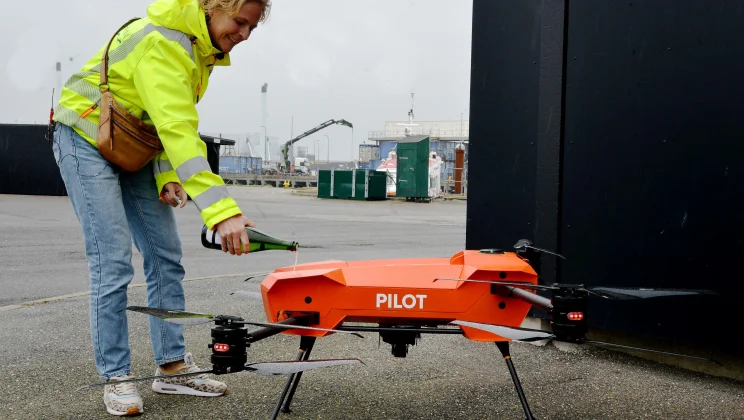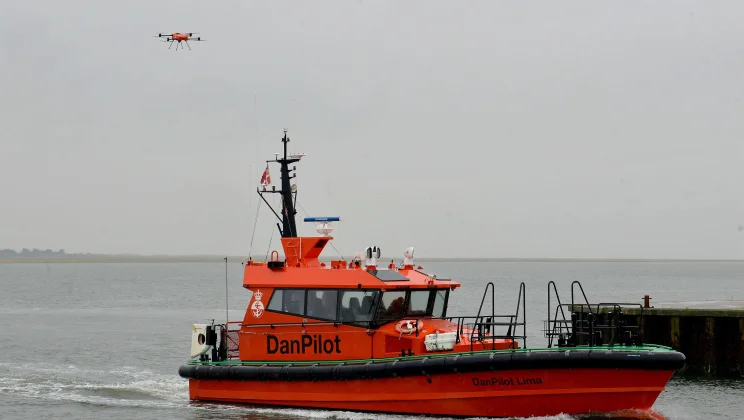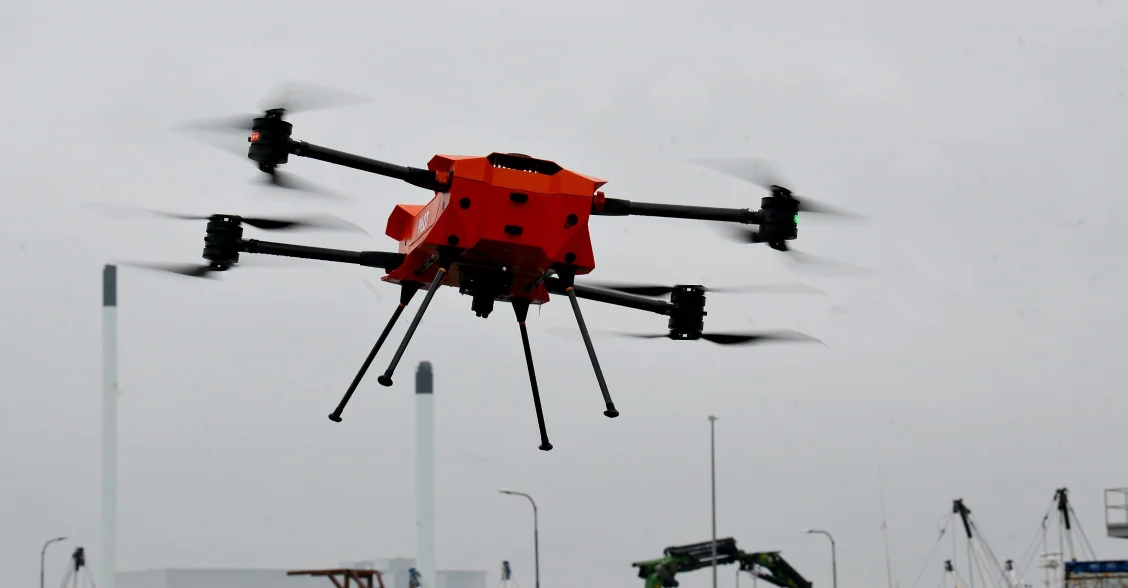The use of drones is set to take Port Esbjerg’s pilot services to new heights in close collaboration with DanPilot and its subsidiary VesCo. Pilots use the drones as their “eyes in the sky” to help them direct vessels safely into Port Esbjerg. This project is cutting edge in Europe and is attracting attention from other European ports.
Seventy-five metres up in the air, the drone ‘Lone’ is hovering over the ARK DANIA, a DFDS RoRo vessel situated 700 metres from the entrance to Port Esbjerg. In the control centre at Port Esbjerg, one of the pilots is giving directions to the captain of the ARK DANIA using live images from the drone.
Port Esbjerg and DanPilot in collaboration with DanPilot’s subsidiary VesCo have launched a drone project to support drone-assisted pilotage. The project is progressing well, and a second drone has just been put into service.
The hope is that the pilot services at Port Esbjerg will be safer and more efficient going forward by reducing the need for the pilot’s physical presence and improving navigation options through the use of drones.
“We have an exciting and excellent collaborative partnership with DanPilot, and the impressive results of the initial tests only raise our expectations. Looking ahead, the development of a new control room at Port Esbjerg will facilitate drone operations to an even higher degree,” says Jesper Bank, CCO of Port Esbjerg.
DanPilot currently has two drones, which are named ‘Lone’ and ‘Nivi’ after two employees. Drones could become a permanent aspect of day-to-day pilotage at the port, but right now the project is in a test phase with the drones being thoroughly tested with different types of test vessels. Both offshore wind vessels and large cargo vessels will be supported by providing a better overview and enhanced port operation efficiency.
The idea came about by chance
The idea of using drones as a supplement to traditional pilotage came about by chance.
Brian Schmidt Nielsen, Project Manager at DanPilot, and his colleagues were working with a vessel simulator when they discovered how valuable a bird’s eye view could be during pilotage. This fostered the idea that drones could provide the same overview in real life, increasing safety and efficiency, not only at Port Esbjerg but at ports around the world.

Lone Arendt Rasmussen christens the drone from Danpilot, which is named after her.
A brand new pilot project
Port Esbjerg has made facilities available for the drone project, including office space and a test area where developers and software engineers can carry out their work. The drone equipment and the control room are set up in dedicated port areas.
Although the drones have been named and introduced at the port, the project is still in an early test phase. The project will contribute to improving the safety and efficiency of vessel calls by combining autonomous technology, vessel data and pilot experience. During this test phase, Port Esbjerg serves as a test platform for a new method of pilotage.
Port Esbjerg is one of Europe’s busiest ports with a wide variety of vessel types ranging from offshore wind vessels to large freight carriers, and the pilots are therefore given the opportunity to test drones in various pilotage situations.
The pilots testing the drones have at least five years’ experience and have been specially trained in drone operations on DanPilot’s ship simulator at Port Esbjerg.
The drone project is not only expected to be used for pilot services – the drones also have the potential to be utilised in other operations at the port.
“The drones can be used for much more than just pilotage. They can also inspect port facilities, such as cranes, thereby saving time and increasing safety as employees will not need to climb up to inspect them physically,” Schmidt Nielsen explains.
Another aspect of the test phase will be to explore the possibilities for autonomous flying with the drones, tracking different vessels entering Port Esbjerg using the vessels’ individual IMO numbers and AIS signals. This could semi-automate the pilot services at the port.
New technology enhances safety and efficiency
One of the aims of the drone project is to make the pilot services more accurate and safer in all weather conditions. With the ability to navigate at wind speeds of up to 15–17 m/s, drones can operate in demanding weather conditions, including strong winds. They can also operate in poor visibility, such as fog and snow, thanks to their infrared cameras.
Drones will give pilots a reliable perspective in situations where pilot boats would otherwise be challenged.
The battery life of drones is currently 40 minutes but is expected to improve significantly in the future. At present, Port Esbjerg and DanPilot operate two drones so a new drone can take over when the other runs out of power.

The drone, named Lone, hovers in the air above the port. The hope is that piloting work at Port Esbjerg will become safer and more efficient in the future by reducing the need for physical presence and improving navigation capabilities through the use of drones.
A bird’s eye view to other international ports
For now, the plan is that the drones will optimise the pilot services at Port Esbjerg. Going forward, the idea is to extend the work with drones to several international ports:
“The drone project may be scaled to other ports by way of standardising control systems and training staff in autonomous navigation procedures so drones can assist in pilotage across different ports,” says Bank.
The expertise of Port Esbjerg is already being utilised at other international ports, including in Germany and the Netherlands where Project Manager Lone Arendt Rasmussen, whom one of the drones is named after, helps develop and plan drone operations.
The plans for drone-assisted pilotage going forward
The next stages of the drone project at Port Esbjerg will focus on testing drone performance under difficult weather conditions and optimising camera angles and camera positions.
At the same time, phase two of the project is being explored, in which two drones will work simultaneously to cover the vessel’s movements from several angles. One drone will typically position itself at the stern while the other will monitor the vessel from the bow or the port/starboard, offering the pilot a complete perspective.
The development of an advanced communication platform will allow the pilot and the captain to share live data and video feeds to monitor the vessel’s course, manoeuvres and surroundings in real time. This phase demonstrates how drone-assisted pilotage can increase the precision and safety of complex pilot services.
Go to overview

